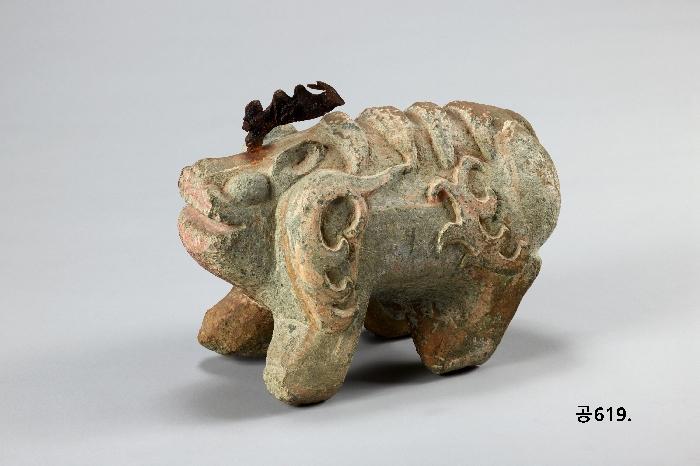
This type of funerary object (Jinmyosu), conceived from a mythical creature with horns and wings, began to be used in the Later Han period (25-220) as a tomb guardian, protecting graves and guiding the spirits of the deceased to the after world. Unearthed from the Tomb of King Muryeong, this particular artifact is the first tomb guardian of its kind to be discovered in Korea. The creature’s mouth and some parts of its body are painted red, a color traditionally used to symbolize the repelling of evil forces. It measures 32.2cm in height, 48.6cm in length, and 24.0cm in width, and weighs 48.5kg. An analysis of the artifact revealed that the creature’s body is made of hornblende and its horns of iron.
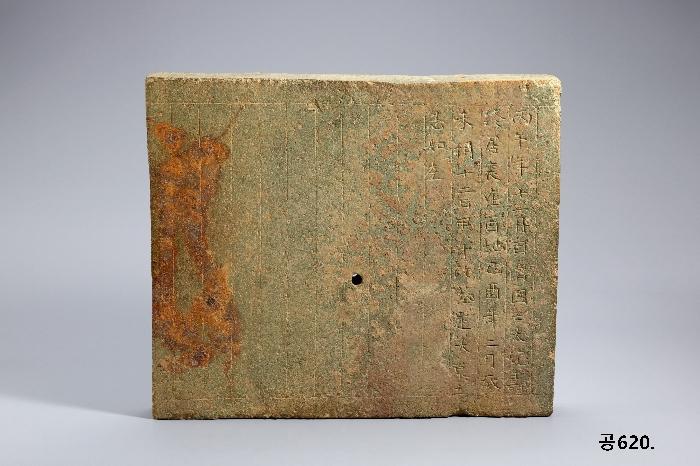
This rectangular funerary plaque is one of two tomb markers, one for the king and one for his consort, discovered at the entrance to the passage leading to the burial chamber of the Tomb of King Muryeong during the excavation of the tomb. This plaque bears an inscription containing basic personal information about the king and the dates of his death and burial. The inscription reads: "King Sama [now better known as King Muryeong, the 25th ruler of Baekje] of Baekje, who was also the Great General of Yeongdong, died on the seventh day of the fifth month in the Gyemyo Year [i.e. 523] at the age of sixty two, and was buried at the Grand Tomb on the twelfth day of the eighth month in the Eulsa Year [i.e. 525]." The rear face of the plaque is engraved with a map of the sexagenary cycle (Ganjido), which functioned as the guide map of the royal tomb.
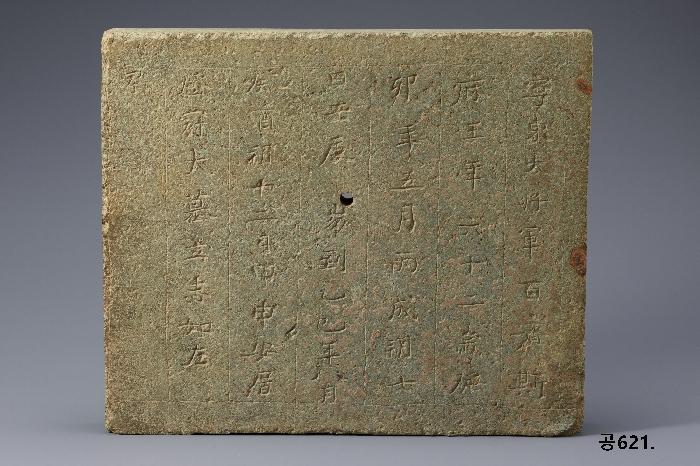
This rectangular funerary plaque is one of two tomb markers, one for the king and one for his consort, discovered at the entrance to the passage leading to the burial chamber of the Tomb of King Muryeong during the excavation of the tomb. This plaque bears an inscription containing basic personal information about the queen and the dates of her death and burial. The inscription reads: "King Muryeong's queen consort died in the eleventh month of the Byeongo Year [i.e. 526]. It was followed by a three-year period of mourning at a site to the west of the tomb, and her body was relocated to the Grand Tomb on the twelfth day of the second month in the Giyu Year [i.e. 529]." The plaque’s rear face is engraved with the "land purchase certificate" (Maejigwon) according to which King Muryeong purchased from the land god a tract of land for use as a grave site for the sum of ten thousand mun [ancient unit of currency].
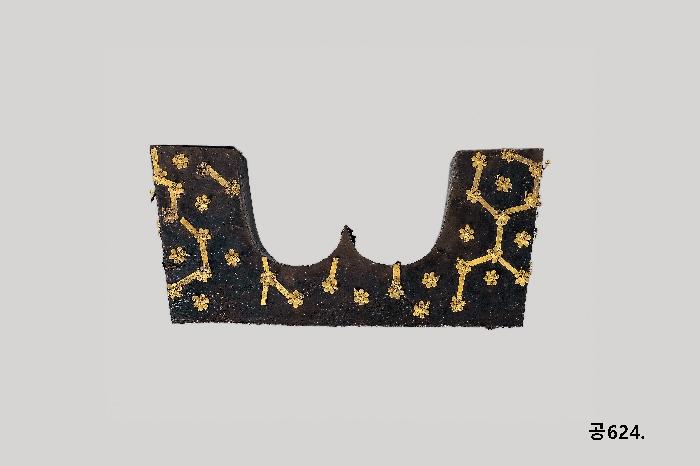
This artifact is a footrest used to support the feet of a deceased Baekje king. It was made by carving the upper portion of a block of wood into a w-shaped form. Its entire surface is lacquered black and decorated with a honeycomb design made with rectangular pieces of golden leaf. Each of the six corners and the center of the golden hexagons are further embellished with golden floral ornaments. These floral ornaments are similar to the lotus flower motif used on the roof-end tiles of Baekje during the Ungjin and Sabi periods, while the honeycomb pattern was inspired by a Buddhist thought from Northern Wei. These decorative motifs reflect Buddhist ideas of the world and life after birth.
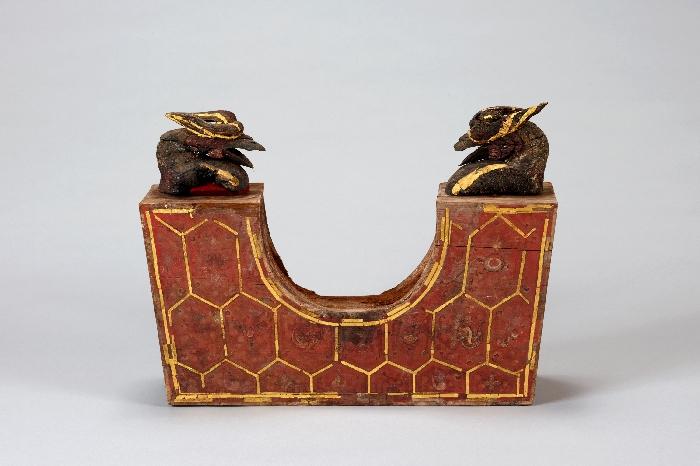
This head rest was used to support the head of the tomb’s occupant. It was made by carving the upper part of a block of wood to create a semi-circular form. Its surface is coated with cinnabar pigments and decorated with a honeycomb design created using narrow strips of gold leaf. Each hexagon of the honeycomb contains the motif of a Buddhist celestial maiden, a lotus, and a makara in black or white ink. The main motif is related with the Buddhist myth about a child who was born in a lotus bud and eventually became an immortal sage. The head rest was also embellished with an ornamental pair of phoenix heads.
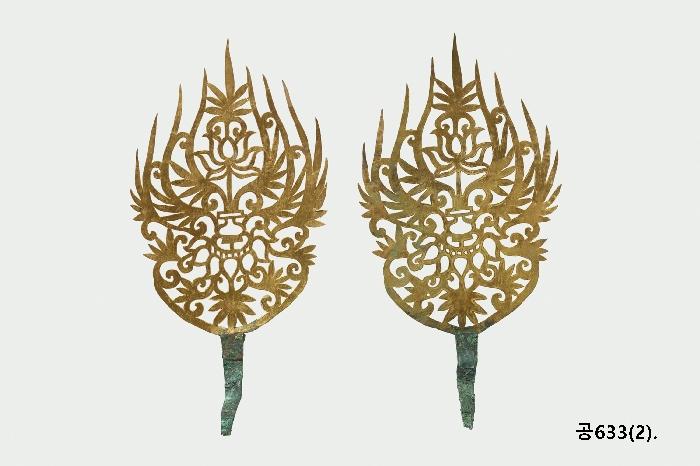
This pair of ornamental artifacts was discovered near the head of the Queen Consort in the Tomb of King Muryeong. It was made with thin gold plates by cutting ornamental designs. A bronze tang is attached to each ornament by three rivets. The queen's crown ornaments lack spangles, and are instead decorated with symmetrically arranged lotus, palmette and "dangling bottle" motifs. Vines spring from the dangling bottles both upwards and downwards, of which those extending upwards form a fire flame design. Each ornament has the overall shape of a blooming lotus blossom.
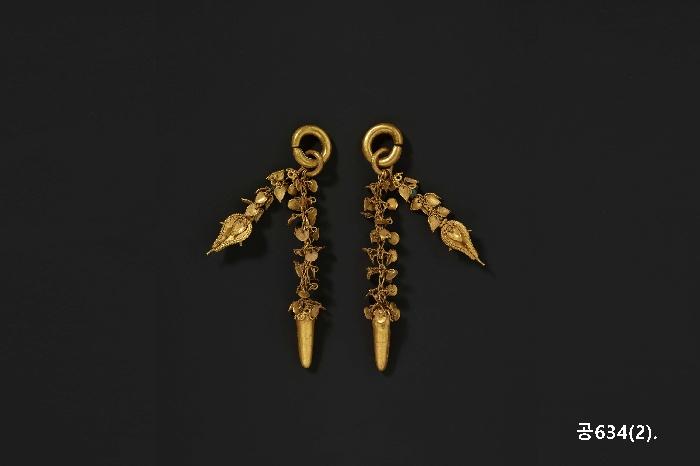
This pair of gold ear ornaments was discovered near the queen's head in the burial chamber of the Tomb of King Muryeong. They consist of hollow rings made by attaching together two semi-cylindrical gold plates, and also have a middle link attached with two dangling chain ornaments, each of which is further embellished with gold leaves. The shorter of the two has a bluish green glass bead on top and a pendant in the shape of a pen nib edged with granules and incisions, while the longer string has a 3cm-long bullet-shaped pendant at the end. The purity of the gold used to make the artifacts is 98.1 to 99.7%.

This pair of gold ear ornaments was discovered near the queen's coffin in the burial chamber of the Tomb of King Muryeong. They consist of three parts, a large ring, an interlink and a hanging ornament, and share similar features with the other pair of gold earrings discovered near the queen's head. Each of the hanging ornaments is chained with gold spangles in the shape of a tree leaf, is topped with a bluish-green glass bead set in a semi-spherical gold ornament, and has a pendant in the shape of a pen nib edged with granules and incisions. The purity of the gold used to make them is 97.0-99.7%.
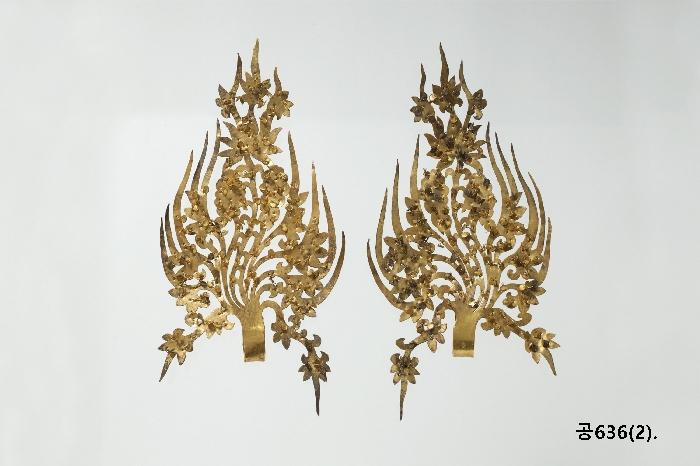
These two crown ornaments were discovered near the head of King Muryeong. According to the chapter on King Goi in the Basic Annals of Baekje, History of the Three Kingdoms (Samguk sagi): "In spring of the 28th year, on the year's first day, the king […] wearing a black silk crown ornamented with gold flowers [...] sat in the Southern Hall and discussed state affairs." The "gold flowers" mentioned in this record refer to the crown ornaments shown here.
The ornaments, lavishly decorated with a dynamic and luxurious flame motif, consist of thin gold plates made by a process of hammering, cutting, and then hanging golden spangles. Each of the artifacts has a u-shaped hook at the base, and is pierced with small holes through which it could be attached to a crown. An analysis of the artifacts revealed that they were made with 98-99.1% pure gold.

This pair of gold ear ornaments was discovered near the head of the king in the burial chamber of the Tomb of King Muryeong. They consist of large rings attached with two strings of end ornaments. One of the two hanging strings is attached with two - one large and one small - heart-shaped pendants and cylindrical middle ornaments edged with gold granules. The other string features five gold globules linked with small rings, with a gold-capped jade pendant attached to the end. An analysis has shown that the ornaments are made of 97.9-99.8% pure gold (Au).
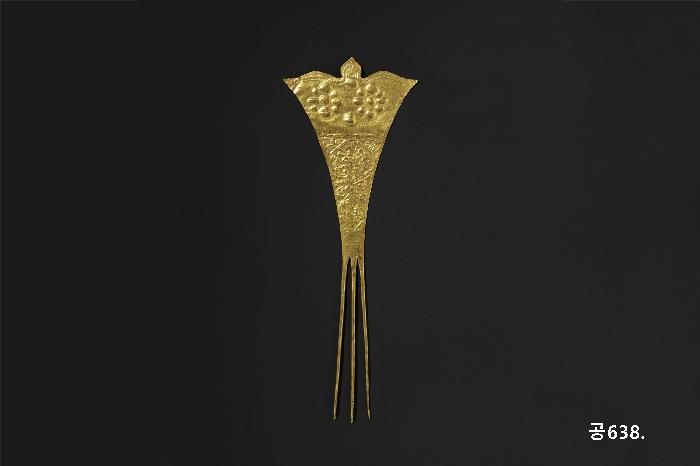
This gold hair ornament was discovered on the bronze mirror found near the head of the king in the Tomb of King Muryeong. It consists of a head shaped like a Buddhist magic pearl (cintamani) or a lotus bud and a main body in the shape of open wings, which taper into a tail divided into three long strands. The surface decoration, consisting of flower petals on the upper part and a vine design on the lower part, was made using the embossing technique.
An analysis has shown that the ornament is made of 92.5-94.2% pure gold (Au), 3.3-3.7% silver (Ag), and 2.3-3.8% pure copper (Cu).
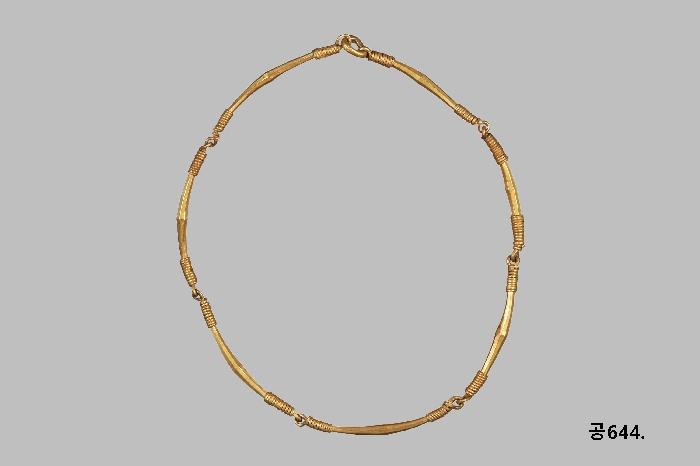
This gold necklace was discovered near the queen's coffin ornament in the burial chamber of the Tomb of King Muryeong. It was made by linking seven gold rods; hence it is often referred to as the "necklace with seven joints". Each rod is about 6cm long and features a multi-faceted tube, which is linked with the other rods by thin chain-shaped interlinks. The design of the necklace is thought to be unique to Baekje because no similar artifacts have been found outside its territory. A similar necklace, consisting of nine joints, was also discovered alongside this item. The purity of the gold used to make the necklace is 98.8-99.0%.

This gold necklace was discovered near the queen's coffin ornament in the burial chamber of the Tomb of King Muryeong. It was made by linking nine gold rods; hence it is often called the "necklace with nine joints". Each rod is about 6cm long and features a multi-faceted tube, which is linked with the other rods by thin chain-shaped interlinks. The design of the necklace is thought to be unique to Baekje because no similar artifacts have been found outside its territory. A similar necklace, consisting of seven joints, was also discovered along with this item. The purity of gold used to make it is 98.8-99.0%.

These silver bracelets were discovered near the queen's left arm in the burial chamber of the Tomb of King Muryeong. Each bracelet has a flat inner face and a semi-circular outer face, and contains an inscription. One of the two is engraved with twin dragons. The silver plate used as a lining for each bracelet bears an inscription composed of seventeen Chinese characters ("庚子年二月多利昨大夫人分二百卅主耳") which reads: "The artisan named Dari made [these bracelets] for the Grand Lady [i.e. the queen] in the Gyeongja Year [i.e. 520] using 230 juri (or su) of silver". Experts believe that the bracelets were made long before the queen's death and were buried in her grave as childhood memorabilia.
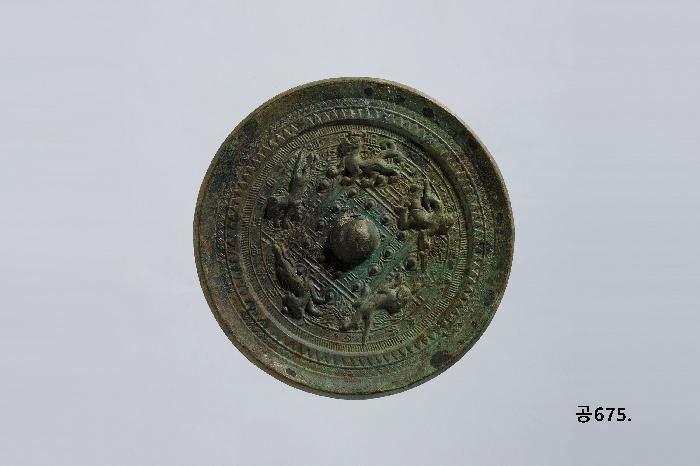
This bronze mirror was discovered near the king's feet in the burial chamber of the Tomb of King Muryeong. The mirror was originally thought to be a copy of a Chinese Han mirror, but some recent researches have concluded that it is a unique product of Baekje. The center of the rear face of the mirror is carved with the twelve symbols of the Eastern Zodiac together with images of a hunter (or Daoist immortal), top-knotted and holding a spear, and various creatures including a single-horned beast.
The principal motif at the center is encircled by a lyrical inscription in Chinese characters (尙方作竟眞大好上有仙人不知老渴飮玉泉飢食棗壽[如]金石兮) which reads: "The mirror made by the court’s artisans was so good that the old Daoist masters never grew old, drank from a jade spring when thirsty, and ate jujubes when hungry, enjoying a life as long as that of a rock."

This bronze mirror was discovered near the king's head in the burial chamber of the Tomb of King Muryeong, and is the largest of all the mirrors found there. The center of the rear face of the mirror is attached with a knob encircled by nine small protrusions, with images of various creatures and three Chinese characters ("宜子孫") arranged between them. The mirror also features an outer circle containing seven larger protrusions, with various images, including the Four Guardian Deities, carved between them, along with a series of Chinese characters related with the idea of the Daoist immortals. A similar mirror was discovered in the Kannonyama Tomb in Gunma Prefecture, Japan, pointing to Baekje’s strong cultural influence on ancient Japan.
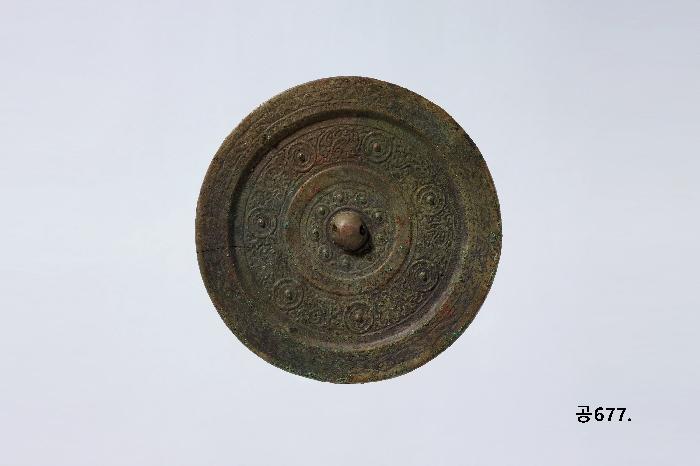
This bronze mirror was found near the queen's head in the burial chamber of the Tomb of King Muryeong. The mirror shares similar features with King Muryeong’s "Uijasonsu Mirror". The rear face of the mirror is divided into three circular sections with the knob placed at the center and surrounded by nine small protrusions, which in turn are encircled by seven large protrusions arranged at regular intervals. The mirror’s outer section is decorated with pairs of whirling circles with various creatures, including the Four Guardian Deities, engraved between them, while its outermost section is decorated with saw-tooth and rope patterns.
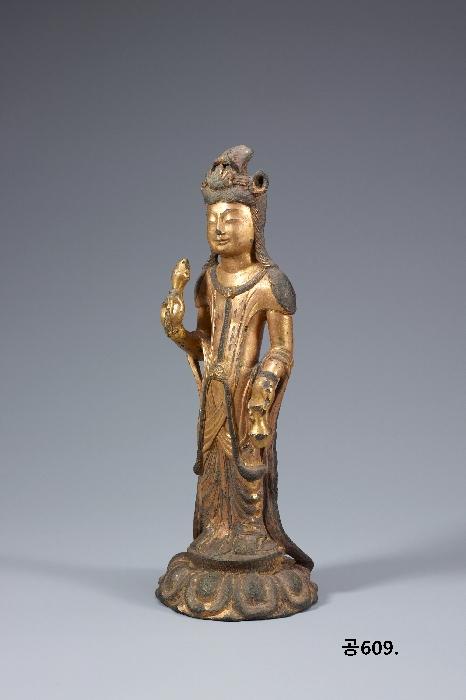
Widely regarded as one of the most beautiful Buddhist figurines of Baekje, this gilt-bronze Avalokitesvara statuette features a delightfully round face with a benign smile, a slim body, long hair divided in two braids falling across both shoulders, a heavenly robe depicted with nicely drawn folds, a beaded belt consisting of two strands with a goblin plaque at the center, and a lotus pedestal on which the deity stands. The folds of the heavenly robe form an X-shape at the front and a u-shape behind the shoulders, typical characteristics of Avalokitesvara statues of Baekje.
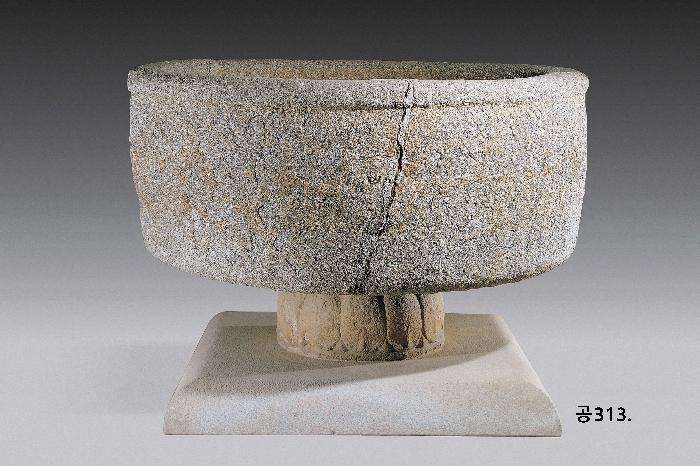
This stone basin is known to have been used at a Buddhist temple to hold lotus flowers. It features the same style and carving techniques as the stone basin of Banjuk-dong, suggesting that they were made to be used as a pair. The basin was made by carving out the center of a granite block in the form of a bowl placed on a short circular stem, which in turn is placed upon the base stone. The stem is decorated with the motif of a lotus with twelve petals. The basin is also decorated with a thick band along its mouth, and a lotus flower with eight petals with a pair of thin strings surrounding the center.

This stone basin is known to have been used at a Buddhist temple to hold lotus flowers. It features the same style and carving techniques as the stone basin of Jung-dong, suggesting that they were made for use as a pair. The basin was made by carving out the center of a granite block in the form of a bowl placed on a short circular stem, which in turn is placed upon the base stone. The stem is decorated with the motif of a lotus with twelve petals. The basin is also decorated with a thick band along its mouth, and a lotus flower with eight petals with a pair of thin strings surrounding the center.
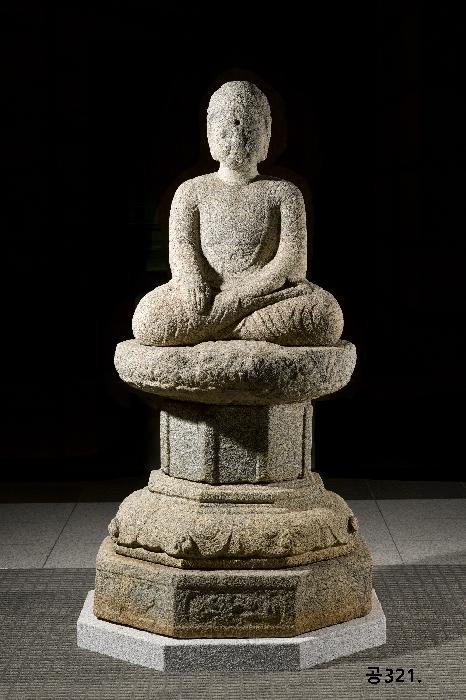
This stone Buddha statue was discovered at the Seohyeolsa Temple site to the east of Mangwolsan Mountain in Ungjin-dong, Gongju-si. The Buddha is depicted wearing a skin-tight heavenly robe draped across both shoulders, with a knotted band at the chest. He is seated cross-legged and displays the symbolic hand gesture meaning "expelling evil by touching the ground", with the right hand placed on the knee and the left hand on the right leg. The pedestal consists of two parts, an upper pedestal carved with upturned lotus petals and a lower pedestal carved with downturned lotus petals and "corner flowers" (gwikkot). The foundation stone supporting the pedestal is also carved with Buddhist motifs, such as heavenly messengers and a Kalavinka, the bird of the Buddhist paradise. The details suggest that the statue was made around the ninth century.